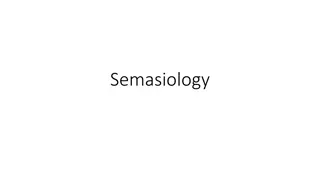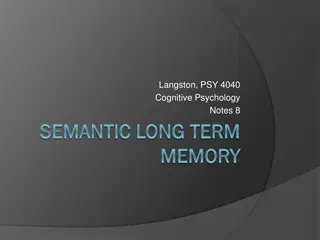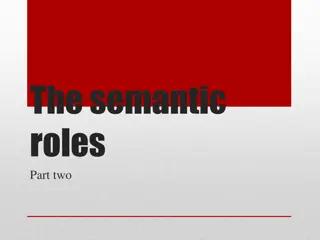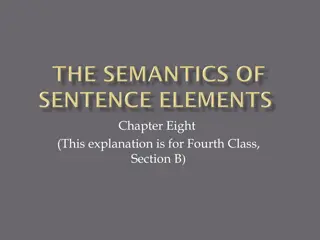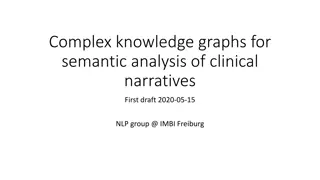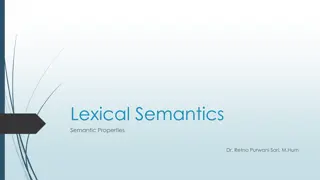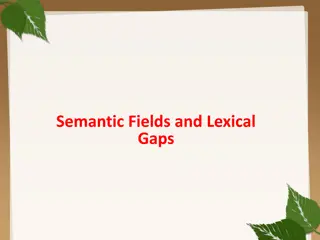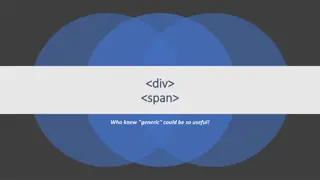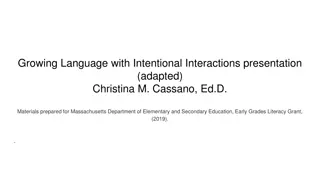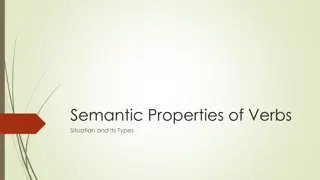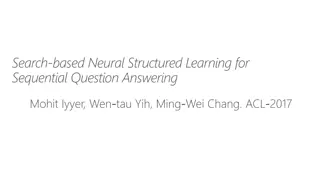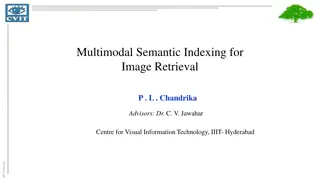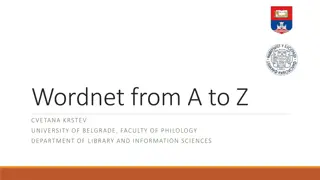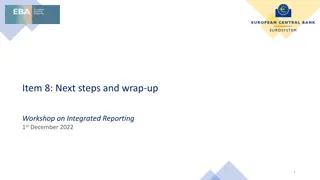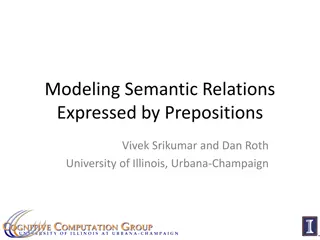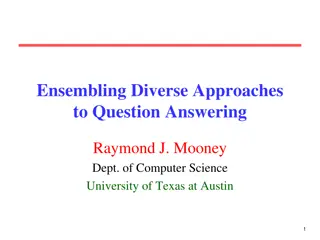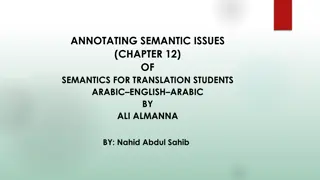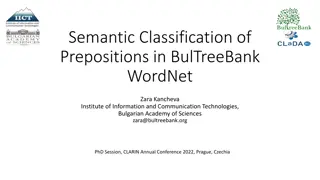Structuring Vocabulary in Language: Semantic and Psycholinguistic Perspectives
The vocabulary of a language is not just a random collection of words. It is structured linguistically and psycholinguistically, with different levels of organization. This text explores linguistic structures in the lexicon, focusing on semantics and sense relations. It delves into taxonomic and meronymic hierarchies, highlighting the importance of paradigms and branching structures. Understanding these structures enhances our comprehension of how words are related and organized within a language.
Download Presentation

Please find below an Image/Link to download the presentation.
The content on the website is provided AS IS for your information and personal use only. It may not be sold, licensed, or shared on other websites without obtaining consent from the author. Download presentation by click this link. If you encounter any issues during the download, it is possible that the publisher has removed the file from their server.
E N D
Presentation Transcript
Ban Ibrahem WORD FIELDS
INTRODUCTION The vocabulary of a language is not just a collection of words scattered at random throughout the mantel landscape. It is at least partly structures, and at various levels. There are various modes of structuring. It is useful, at the outset, to distinguish two major types of structure, the linguistic and the psycholinguistics Linguistics structures in the lexicon are defined linguistically those which we shall be concerned with here are defined semantically, in term of meaning relations; Psycholinguistics structures are defined in term of such properties as associative links, priming characteristics, and patterns of speech error. In this chapter we will concentrate on aspects of linguistic structuring in the lexicon.
Linguistic structures in the lexicon may have phonological, grammatical, or semantic basis. Obvious examples of grammatical structure are word classes( grouping of words according to their syntactic properties)and word families ( set of words derived from a common root). We shall concerned with semantically defined structures, particularly those generated by sense relations, or set of sense relations. We begin with those based on paradigmatic sense relations.
Hierarchies Taxonomic hierarchies Meronymic hierarchies Taxonomic hierarchies : Levels The basic level other levels Number of levels Gaps and autotaxonomy Real-life taxonomies Meronymic hierarchies : Levels Lexical gaps Contrastive aspects 1. 2. 3. 4. 5. 6. 1. 2. 3.
Hierarchies One of the most important types of paradigmatic structure in the lexicon is the branching hierarchy, which prototypically has the form shown in the next slid
A B C F G D E
A given type of hierarchy can be characterized in term of two relations, a relation of dominance and a relation of differentiation. The relation of dominance is the one which holds between A and B, and C,B and D,B andE,C and F, and C and G, and it is symbolized by the lines joining the nodes ( branching points ) The relation of difference is the one which holds between (B and C )and (D and E) and (F and G ) in a well formed hierarchy is that the branches never come together again as one descends the hierarchy ; to put it in another way( the so-called unique mother constraint). In a lexical hierarchy, which is the sort that concerns us here, A, B, .G correspond to lexical items (or more accurately, units of senses ).
There are two main sorts of lexical hierarchy : Taxonomic(or classificatory) hierarchies, in which the relation of dominance is taxonomy (or, more accurately, its converse, for which there is no special name) and the relation of differentiation is co-taxonymy, and Meronomic (or part-whole) hierarchies, in which the relation of dominance is meronymy or more accurately, holonymy) and the relation of differentiation is co-meronymy
1-TAXONOMICHIERARCHIES Are essentially classificatory systems, an they reflect the way speakers of language categorize the world of experience, a well formed taxonomy offers an orderly and efficient set of categories at different levels of specificity
1-LEVELS A characteristic of taxonomy hierarchies is that they have well-developed levels. As illustrated, tableware is at level 1, cutlery, etc. at level 2, fork . Tablecloth at level 3, and so on. Only four levels have been shown, but it is arguable that this is only a fragment of a larger hierarchy of something like household goods, in which the sister nodes to tableware would be occupied such items as appliances, furniture, sofa furnishing, and so on.
Levels can be established in two ways, which is a prototypical hierarchy give the same answer, but in real-life hierarchies sometimes diverge. To determine the level of an element by the first method one simply counts the nodes to the top of the hierarchy (the unique item which dominates all the others in the hierarchy, the beginner).by this method, one can easily determine that tablespoon is at level 4. Levels established by counting nodes are called technical levelsin Cruse (1986). The other approach to levels consists in looking for distinctive characteristics of the items at different levels. This approach yields substantive levels ,it displaying the richest set of characteristic properties is undoubtedly what psychologists call the basic level , and anthropological linguists, the generic level. which is the basic level
2-THEBASICLEVEL The main characteristics of the basic level and the items that occur there are as follows: Basic-level categories maximize two properties of good categories resemblance between members, and distinctiveness of members from those in sister categories. In categories at high levels, internal resemblance diminishes; at low levels, external distinctiveness diminishes . Basic-level categories are thus the most efficient in the whole hierarchy. Basic-level categories represent the highest level for which a clear visual image can be formed. It is easy to visualize a spoon, but less easy to visualize an item of cutlery (without selecting one representative example). Likewise, a dog is easy to visualize, but an animal is not.
Basic-level categories represent the highest level for which characteristic patterns of behavioural interaction can be described. Suppose one were asked to mime how one behaved with an item of furniture. Impossible with, say, a chair ( a basic-level item), however, there would be no problem. Similarly, knife would be easier than item of cutlery, and horse than animal. Basic-level terms are used for everyday neutral reference; they are, as it were, the default terms for normal use: the use of non-basic-level term needs to be specially motivated. Thus, Would you like an apple? Is more normal than Would you like a Golden Delicious?, even if the fruits on offer were of that variety, or needed to be more specific to distinguish those apples from those of other varieties. Similarly, who s going to feed the dogs today? Is generally more appropriate as a neutral question than who s going to feed the animal today? Which is less specific.
Anthropological linguists point out that basic-level items tend to be morphologically simple (this applies to all the items in our example except tablecloth) and no barrowed by metaphorical extension from other areas of the vocabulary.
3- OTHERLEVELS Vocabulary items at levels below the basic level are more likely to be compound words than those at the basic level ( think of teaspoon, tablespoon etc.). In hierarchies where the basic level items are count nouns, the items at higher levels are frequently mass nouns. This is particularly the case for artefacts (or more generally, words in whose meaning functional rather than perceptual features are dominant, that is not for biological species: cutlery, crockery, furniture .etc.
4- NUMBEROFLEVELS Reached by anthropological linguists has shown that taxonomic hierarchies which appear in everyday language rarely have more than five or six levels, and even this number is uncommon: they mostly occur in small fragments. Our example has four levels, five if we include household goods. The number limitation does not apply to expert, technical vocabularies. 5- Gaps and autotaxonomy Lexical gaps are not infrequent in taxonomic hierarchies, especially in levels above the basic levels. We speak of a lexical gap when there is intuitive or other evidence of the existence of well-established concept corresponding to the point in the structure where the gap occurs . For instance , there is no superordinate ( in English ) for the set of verbs of going under one s own stream on land ( for an animal or human ) , whose hyponyms would be crawl, walk, run, hop, etc. Nor is there a word for the general notion of going under one s own stream , whose hyponyms would include the ( missing ) word just mentioned,
Together with swim and fly, and so on. There is no everyday term for devices for telling the time (timepiece belongs to a different register from clock and watch). There is no everyday term in English for members of the animal kingdom: creature is from a more formal register, and animal in this sense ( as the animal kingdom) only occurs in technical registers. Sometimes ( what would otherwise be ) a gap in a hierarchy is filled by an extended sense of an item immediately above or below it. It is not always easy to tell which is the original sense and which the extended sense ). The following example is A: Haven t you got any trousers to wear? B: yes, I ve got my new jeans. A: Are you going to wear your jeans? B: No, I think I ll wear my trousers The reading marked 1 with the superordinates of those marked 2
6- REAL-LIFETAXONOMIES real-life taxonomies are often not so straightforward: branches seem to converge and the position in the hierarchy of common lexical items may seem obscure. One of the complicating factors is the existence of terms with a restricted perspective alongside the purely or predominantly speciating ('kind forming', i.e. taxonymic) terms. The field of clothing will be used to illustrate these points. We shall take clothing as the beginner of the clothing taxonomy (notice that there is arguably a more inclusive taxonomy of "things you can wear", which would include, for instance, watches and perfume)
The first true taxonyms we encounter as we go down the hierarchy are those at the basic level: trousers, jacket, dress, skirt, shoe, bra, knickers. There seems to be no intermediate level corresponding to cutlery and crockery in the tableware hierarchy. However, the picture is complicated by the existence of various sorts of restricted perspective-terms, which look at first as though they were the counterparts of cutlery and so on. Some of the perspectives are:
where worn relative to body: underwear, footwear when worn: evening wear, nightwear who wears it + only visible to intimates: lingerie worn while doing what: sportswear, slumber wear
There is no term for everyday, publicly observable, not-for- special-purpose clothing; this type functions as a kind of unnamed default category, only deviations from which are lexically distinguished. Notice the following points. A further specification of 'lingerie' would need to mention vest, knickers, nightie, pajamas. But the first two are underwear, and the latter are night/ slumber wear. However, men's vests and men's pajamas are not lingerie. If we call the default clothing neutral wear, then a reading of dress, let's call it dress1, will appear amongst its taxonyms/hyponyms. But this is a hyponym of a more general reading of dress, dress2, which includes both dress1 and evening dress. Tennis shoe is a hyponym of sportswear, but shoe is also hyponymy to evening wear and footwear. All this makes it virtually impossible to construct a well formed hierarchy from clothing terms. The appearance of chaos can be mitigated if we bear in mind the following points:
(i) Neat hierarchies appear only if the perspective is kept constant; if this is not the case, cross- classification can occur. (ii) Each perspective potentially yields a separate hierarchy, (iii) Different hierarchies can intersect in various ways (iv) With the possible exception of hierarchies with unmarked perspective, the elements in taxonomic hierarchies are not full lexical senses, but contextually circumscribed subsenses.
7- CONTRASTIVEASPECTS The taxonomies of different languages can differ not only in the names of the categories, but also in which categories are recognized. A few examples of this will suffice. Take first the term animal in English, in its everyday sense which contrasts with bird, fish, and so on. Strange as it may seem to English speakers, there is no such category in French, and it is difficult to explain to speakers of French exactly what the category comprises. The French word animal designates all members of the 'animal kingdom', including birds, fish, insects, etc. The nearest equivalent to this in English, although it does not belong to the same register as the French word, is creature. There is thus no single word translation of animal in, for instance, The Observer's Book of British Wild Animals; it has to be rendered as something like Les Mammiferes, Reptiles et Amphibiens Sauvages de la Grande Bretagne
2- MERONYMICHIERARCHIES The second major type of lexical hierarchy is the meronomy, in which the relation of dominance is (the converse of) meronymy, and the relation of differentiation is co-meronymy. Probably the most familiar of the extensive meronomies is the segmental version of the human body as seen from the outside. Some of the details of this hierarchy are disputable; for instance, whether shoulders are parts of arms, as shown, or parts of the trunk. Commonly encountered machines also have well- developed meronomies associated with them, but few people who are not experts could give a full account of the parts of a car, washing machine, or computer. Most of our knowledge is in the form of fragments of meronomies.
1- LEVELS The major formal difference between a taxonomy and a meronomy is the lack of clear generalized levels in the latter. In a sense the body meronomy illustrated is uncharacteristic because of the homologies between the arm and the leg: knee corresponds to elbow, sole of foot to palm of hand, toes to fingers, etc. But this does not extend to other parts of the body. Speakers have no intuitions as to whether, for instance, the fingernail is or is not at the same level as the anus, or, in a different domain, the hub-cap to the scat cushions or the carburetor jets. For this reason, there seems to be no equivalent to the basic level of a taxonomy, no unmarked level of specificity independent of context. Of course there are unmarked levels of specificity in particular contexts, but these appear to be governed by something like Gricean principles
For instance, one would be more likely to say Mary felt someone touching her arm than Mary felt someone touching her upper arm: the latter would require special contextual conditions. (Even though the arm is part of the body, Mary felt someone touching her body would be interpreted differently.) On the other hand, Ahmad came into view, the falcon chained to his wrist would be more likely than Ahmad came into view, the falcon chained to his arm (it is not immediately clear why this is so).
2- LEXICALGAPS In a taxonomic hierarchy, the beginner is frequently not lexicalized. This is never the case in a meronomy. Gaps do occur, however, and most often in a characteristic position: not infrequently, the main functional part has no name, and speakers are embarrassed if they are asked to supply it. For instance, what do we call the part of a teapot to which the spout, handle, and lid are attached? Some people reply: But that is the teapot other responses are bowl and body. But there seems to be no fully established term. Another example: a spoon has two main parts, the handle and the ?????. Again the response is usually hesitation and embarrassment, with some again suggesting bowl and body. Yet another example concerns the part of a pair of spectacles to which the arms are attached.
Some apparently 'accidental' gaps are found, such as the part of a fork to which the prongs are attached (or, indeed, the part of the hand to which the fingers are attached, and of which the palm and the back are parts). These are, however, relatively rare. In some cases we find automeronymy, that is, when part and immediate whole have the same name (but distinct senses, cf. autohyponymy). A good example of this is to be found in the human body meronomy. The term body is used both (i) for the whole ensemble and (ii) as a close equivalent to trunk (it is, in fact, perhaps the more usual term). It is body in sense (ii) which is the metaphorical source of the suggestions of body for the main parts of teapot and spoon. Other possible examples of this are arm, in two senses, one which includes hand and one which excludes hand, and wheel, which has two senses, one including and the other excluding tyre.
3- CONTRASTIVEASPECTS Languages typically show differences in respect of the way wholes are divided into lexically distinguished parts, although there are reasons to believe that the underlying principles are more or less universal. This means that differences are mostly confined to: different groupings of the same smaller units differences in how far subdivision is carried. Radically non-congruent divisions are rare. i) ii)
An example of (i) is provided by English and Modern Greek in respect of divisions of the arm. In English, hand extends to the wrist and no further; in Modern Greek (which is not unique in this respect), xeri goes up to the elbow. There is a parallel relation between foot and podi: the latter extends to the knee. Notice that both systems respect the joints as natural boundaries for parts. Which part of xeri is being referred to in a particular instance is left to context to determine (there is rarely any ambiguity). But since the part of xeri which corresponds to hand is the most salient part, and overwhelmingly the most frequently involved in activities and so on, in the vast majority of contexts, little is lost by translating, or otherwise equating hand and xeri.
The other type of difference appears when one language provides finer divisions than another. One might say, for instance, that pommette in French is a subdivision of the part denoted in English by cheek (and French joue). The pommette is the rounded part of the cheek over the cheekbone; cheekbone will not do as an equivalent, because one cannot say She has red cheekbones, whereas in French one can say Elle a les pommettes rouges (this would go into English as red cheeks). Another example is the Turkish word ense, which means "back of the neck". It is worth asking whether the absence of an English equivalent for pommette or ense represents a lexical gap or a
conceptual gap. This distinction is by no means always easy to make, although there are clear cases. For instance, for French speakers, there is no natural category to which peanuts, almonds, and walnuts belong (English "nuts"), nor one which includes rabbits and frogs and crocodiles, but excludes birds and fish (English "animals"). Here we have a conceptual gap. On the other hand, English speakers would probably agree that there was a useful concept of "animal locomotion", but since we have no verb denoting just that, we can speak of a lexical gap. In the case of pommette, there is probably a conceptual gap: English speakers feel no need to single out this area of the cheek. The case of ense (cf. French nuque) is less clear. The concept is easy enough to grasp for English speakers, but then so are concepts like "the right side of the head" and "the underside of the tongue", which English speakers can construe when necessary, but which would not be felt to be salient enough to merit lexical recognition. It might also be relevant to ask whether there is any sign of (incipient) lexification of back of the neck, such as non- compositional specificity of meaning (as in the case of blackbird), or morphological evidence such as the existence of fingertip, but not *nosetip alongside tip of the finger and tip of the nose: these would point to the emergence of a lexifiable concept. All things considered, my intuition is that ense, like pommette, does not designate a viable concept for an English speaker.
LINEARSTRUCTURE Bipoles The simplest kind of linear structure is a pair of opposites Bipolar chains Its when the pair of opposites is host to a number of terms that denote different degrees pf property. The above terms are of tow types: A. implicit superlative terms B. attenuative terms
A. implicit superlative terms Denote a polarity switch between the basic antonymy pair For example: minuscule tiny small large huge gigantic Can by characterized as follows: 1. They are resistant to grading: Very small : Tiny 2. They can be prosodically graded to underline a property 3. They can be modified by using the a low bitch unstressed (absolutely): absolutely huge, absolutely tiny 4.Affixation of ish can not be used: largish smallish
MONOPOLAR CHAINS In monopolar chains, there is no sense that terms at the ends of the chains are oriented in opposite directions. There are various different types of monopolar linear lexical structures. There are also various possible ways of describing and classifying them. Degrees: Degrees incorporate as part of their meaning different degrees of some continuously scaled property such as size or intensity, but there is no relation of inclusion. Their boundaries are typically vague, and they have intuitively not lost all their gradability An example of the second type is: Mound hillock hill mountain Notice that these encapsulate some notion of size, but do not actually refer to sizes, but to types of earth protuberance. Other examples are: 1.
Glance look stare 2. Stages: are points in a lifecycle of something and normally involve the notion of progression: Infancy childhood adulthood old age 3. Measures: are based on a part-whole relationship, with each whole divided into a number of identical parts; there is typically a geometrical relationship between values of the scaled property Second minute day week month (etc.) 4. Ranks: In ranks the underlying property does not vary continuously, but in discrete jumps; there is none the less something that a term has more or less of than its neighbors: lecturer senior lecturer reader professor 5. Sequences: There are also ordered terms for which this does not seem to be the case; these are called sequences. There is nothing that Tuesday has more of than Monday: Monday Tuesday Wednesday Thursday
4- GRIDS Grids are generated by recurrent concrete sense relations, or, which comes to much the same thing, by recurrent (and therefore independent) semantic components. The unit of a grid is the cell, which consists of four lexical items, any one of which must be uniquely predictable from the remaining three. The following are examples of cells: (i) man woman [x]:male [x]: female Ram ewe [x] :male [x]: female (ii) hand finger [x] [x]: Digit foot toe [y] [y]: Digit (iii) dog puppy[x] [x] : young cat kitten [y] [y]: young (iv) take steal [v.(1)] [illegally] kill murder[ v.(2)] [ illegally]
Notice that the following is not a well-formed cell: flower tulip animal cat In a sense, the relation of taxonymy recurs, here. But the criterion of full predictability of any item from the other three is not met. Prediction is possible in one direction: flower tulip ? cat
A word needs to be said about the relations involved in these structures. In many cases, these are simply concrete versions of already familiar relations. Consider (ii). The relation between hand and finger is (a concretely specified version of) the familiar one of meronymy, and that between hand and foot is (a concretely specified version of) co-meronymy. But what of the relation between finger and toe? They are not co-meronyms, because they are not parts of the same (immediate) whole. This is a new relation, which appears only in connection with recurrent concrete relations: in Cruse (1986) terms related as finger and toe are, are termed analogues (the relation may be called analogicity). Another example of analogicity is: headmaster school
It is clear that the introduction of concrete relations has brought with it whole new dimensions of structuring in the lexicon. An important and interesting question is whether there is a finite number of such structures, or whether the number is indefinitely large. Even if the number turns out to be indefinitely large, there is still a question of whether the number of distinct relations is finite (indefinitely large structures could in principle be generated from a finite number of relations). but it bears mention that some linguists believe the number to be limited. All the grids illustrated above have been paradigmatically consistent. But there is nothing in the notion of a grid which imposes paradigmatic constraints. The following are well-formed grid cells:
pen write bird fly dog bark However, there must be a paradigmatic relation between analogues; for instance, anything which bears the same relation to something else as pen does to write, or spade to dig, must be a noun
CLUSTERS Are essentially a group of synonyms, and they are of two kinds: Centred Clusters: has a more or less clear core of one or two items, and a penumbra of more peripheral items. Among the characteristics of the core items are: (i) They are expressively neutral. (ii) They are stylistically unmarked, that is, they occur in a wider range of registers than any of the other terms. (iii) They are propositionally superordinate.
In the set: die, pass away, pop off, decease, breathe one's last, kick the bucket, die is clearly the core member: it is expressively neutral, and stylistically unmarked. Feature (iii) is not applicable, since the members of the set are all propositional synonyms. In the set: walk, amble, stroll, stride, saunter, walk is the core item: there is no marked expressive variation in this set, but walk is stylistically unmarked, and is a superordinate of all the others. Although amble, stroll, and so on are hyponyms of walk, they do not form a satisfactory hierarchy, because the relation of difference is too weak: there is considerable overlap between, say, amble and stroll, which can be differentiated only by examining their prototype centres.
Non-centred clusters the items spread over a spectrum of sense, but there is no superordinate item. Typically they display very slight propositional differences, which do not destroy synonymy as long as the items are reasonably close together on the spectrum, but may not be felt to be synonyms if they are widely separated. Typical examples are (taken as referring to sounds): rap, tap, knock, slap, thwack, crack, bang, thump, bump, pop, tick, click, ring, tinkle, clink, clank, jingle, jangle, ping,.. . Clusters may overlap: this is unusual and non-canonical in taxonomic and meronomic hierarchies. For instance, the following two clusters overlap:(i) unusual, rare, uncommon, infrequent, etc. (ii) odd, queer, strange, weird, peculiar, extraordinary, alien, etc.
Group (i) consists of words denoting low frequency of occurrence, whereas the words in group (ii) denote unfamiliarity (of course, these notions are not unconnected). Although the groups are in a sense distinct, intuitively, unusual, odd, and strange (at least) are felt to be synonyms.
MISCELLANEOUSTYPES Other important groupings of words, for which the notion of structure seems less appropriate. Two examples will be mentioned. First, there are the so-called word families. These are words derived from a common root, like cook (v.), cook (n.), cookery, cooker, cooking (n.), etc. Of course there are semantic processes at work here which recur with other roots, but there does not seem much to say about this group of words (or other similar ones) as a group. Second, there are groupings of words by, for instance, register, as in colloquial or formal use, or by field of discourse, such as the vocabulary appropriate for (and possibly restricted to) a religious sermon, a legal document, or a medical textbook. Again, as structures these have no particularly striking properties.
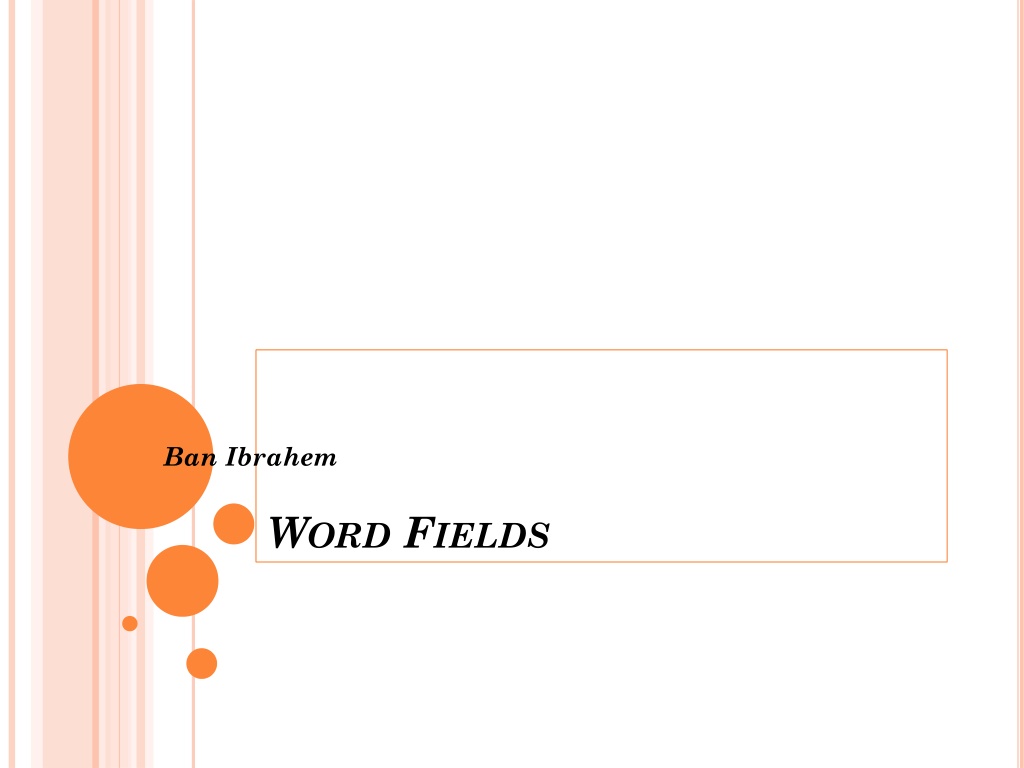
 undefined
undefined

















